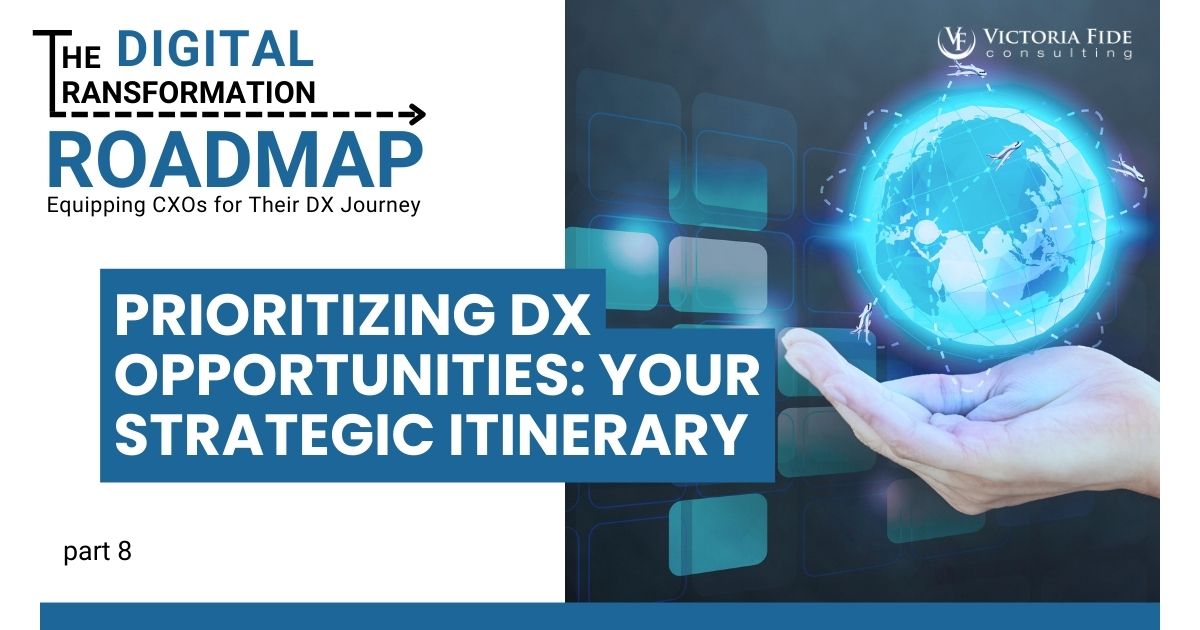
Prioritizing DX Opportunities: Your Strategic Itinerary
The DX Roadmap series is produced by Victoria Fide Marketing with input and oversight from our leadership team and industry SMEs.
Table of Contents
If you’ve been following along with this series, you’ll know we have been exploring digital transformation (DX) through the lens of world travel. Last week we talked about bringing the results from your assessments to a DX “trip advisor” to turn them from goals and obstacles into a bucket list of opportunities for your journey. This week, we will be taking that bucket list and ordering them based on priorities and dependencies to ensure you hit all your landmarks in the most efficient and effective way possible.
We call this step Defining Organizational Priorities. Think of this as outlining a strategic itinerary for your DX journey. This process of prioritizing will help you identify the projects and opportunities that will give you the most value, and set an order based on 3 filter criteria: business objectives, dependencies, and estimated ROI. By the end of this process, you will know which transformational opportunities to prioritize first, and which you can afford to postpone until a later date.
Watch this short video to hear founder & CEO Tory Bjorklund talk about how to prioritize DX opportunities.
Setting the Compass: Directing DX Initiatives Toward Business Objectives
Earlier in the Prepare phase, you have undergone a series of business and technology vision meetings to determine the vision for your company and your transformational destination. With the results from your Transformational Opportunities Assessment, you will now be able to compare each opportunity against the vision for your organization and the business objectives your leadership team has agreed upon.
For example, let’s say that one of your business objectives was to lower warehousing costs. During your opportunities assessment you discovered the need for updated scanners in the warehouses, which would provide significant improvement and long-term cost reduction, thereby supporting that goal. This opportunity can then continue through to the next phase of prioritization before being strategically placed on the itinerary.
However, if your primary business objective is to add a new product line and get into a new market, updating the warehouse scanners does not directly support that goal. While the upgrade does present a good opportunity, it is not a current priority and therefore does not fit into your current roadmap.
Prioritizing this way can be difficult, as there may be a good many opportunities on which you may like to capitalize, but they don’t align with your organization’s goals. It’s critical to keep your eye on the prize. If you deplete your resources chasing after every “good” opportunity, there’s a high likelihood you will never reach the destination you had envisioned from the beginning. This is why it is crucial to stay committed to your objectives and ruthless in your prioritization.
However, before you throw out an opportunity for not aligning with your organizational priorities, there’s one more thing to consider: the matter of dependencies.
Decoding Interconnectivity: A Guide to Dependency Identification
Even if an opportunity doesn’t match your current priorities, don’t rush to dismiss it. Other opportunities that do align with crucial objectives may rely on this one being fulfilled first. Comb through the list of opportunities and identify any that are dependent on the opportunity you’re evaluating, or if this opportunity is dependent on any others. These dependencies fall into three different categories to consider: Strategic, Operational, and Technological.
Strategic Dependencies
A strategic dependency – or company dependency – is one where a certain opportunity or project is reliant upon an existing company strategy, or the company strategy is reliant upon an opportunity or project. For example, if a business objective is to increase sales by 30% over the next 2 years, but their plants are inefficient, increasing plant efficiency is not directly related to increasing sales on the surface, but rather it is a strategic dependency in order to reach their sales goal. In short, they may not be able to deliver on their increased sales if they do not first increase their plant efficiency.
Operational Dependencies
We also refer to this as process dependencies, as it generally relates to specific processes. In one instance, a company’s goal was to lower their inventory costs by reducing their inventory. During our transformational opportunity assessment, we discovered that the root cause of their inventory issues was a lack of forecasting information. In order to reach their inventory turnover goals, they needed to prioritize establishing a reliable forecasting process.
Technological Dependencies
In some cases, your current technology infrastructure will not support your business goals and you must prioritize upgrading your infrastructure before you can realize your objectives. One of our clients was undertaking a $34M ERP implementation. After months of preparing for this large digital transformation, the project ground to a halt due to their Wi-Fi network being unable to support the warehousing system. A relatively small $100,000 technology fix had been overlooked and ended up delaying the ERP rollout significantly. It’s important to weigh all the information identified in your Enterprise Technology Review to identify any technological dependencies and prioritize those accordingly.
By identifying dependencies across these three categories, you will be able to determine which things need to be done first before you can reach your business goals. Just like with planning a trip to see famous landmarks in Europe such as the Colosseum, Eiffel Tower, Leaning Tower of Pisa, and Stonehenge, there is a certain sequence that makes the most sense as you venture across the continent.

Transformation is not easy, but it doesn’t have to be impossible. Take control of your project’s success today and schedule a free 30-minute consultation to find out how Victoria Fide can equip you for transformational success.
Beyond Numbers: Evaluating the Nuance of Transformational Cost
Once you’ve identified if the opportunity is aligned with your business objectives or is a dependency for other aligned opportunities, it’s time to measure its estimated return on investment (ROI) before you can place it in the right order in your roadmap. To measure your ROI effectively, you need to have a clear picture of the cost compared to the benefits.
This article isn’t the space to delve into calculating ROI, as there are numerous tools available to guide you through the rather straightforward formula. Instead, the goal of this article is to encourage you to evaluate your ROI with a greater level of nuance than is typical.
Return
When evaluating ROI, there are two different types of return to consider: savings and earnings. Savings refers to anything that will save you money: increased efficiency, lower maintenance cost, increased productivity, lower product waste, etc. These savings are generally viewed as something that will pay for itself over a period of time.
Earnings encompass anything that will increase your revenue: adding a product line, boosting sales, expanding to a new market. Any increase in your existing revenue falls under this classification.
Investment
Similarly, investments fall into two different categories: tangible and intangible. While most people think to evaluate the tangible cost such as purchasing new systems, hiring implementation partners, building new locations, and even the time that business process owners (BPOs) and subject matter experts (SMEs) will spend during the project, few people recognize the true cost of the intangible investments. Intangible investments encompass factors such as the added stress on you and your team, as well as the potential for burnout resulting from this project.
This is where you will need to evaluate the risks you identified in your Organizational Risk Assessment. If the project has high risk and low return, its ROI should rank lower than a project with similar financial return but lower risk. Although it is difficult to quantify, it is worth considering the impact this project will have on your team. Even if the impact is intangible, that doesn’t mean it isn’t observable. Ultimately, your ROI evaluation should consider both tangible and intangible factors to ensure a nuanced understanding of each opportunity’s potential impact.

Cruising Through the Twists and Turns of Digital Transformation
After evaluating each of your opportunities by aligning them with business objectives, identifying dependencies, and evaluating estimated ROI, you will have a prioritized list of all the opportunities needed to achieve your organizational goals. This strategic itinerary will become the foundation for building a detailed Technology Roadmap, which we will discuss in next week’s article.
In conclusion, by following this structured process of defining your organizational priorities, you can ensure an effective approach to reaching your destination. This methodology not only enhances the efficiency of the decision-making process but also significantly increases the likelihood of success in your digital transformation journey. With a detailed roadmap outlining prioritized projects in hand, you will be well-equipped to guide your organization through the twists and turns of digital transformation.
Stay ahead in your DX journey by subscribing to our LinkedIn newsletter and contact our digital transformation experts for more information on how Victoria Fide can serve as your experienced trip advisor, guiding you on your path to digital excellence.
Subscribe to our weekly LinkedIn Digital Transformation Success newsletter and get notified of each new edition.
